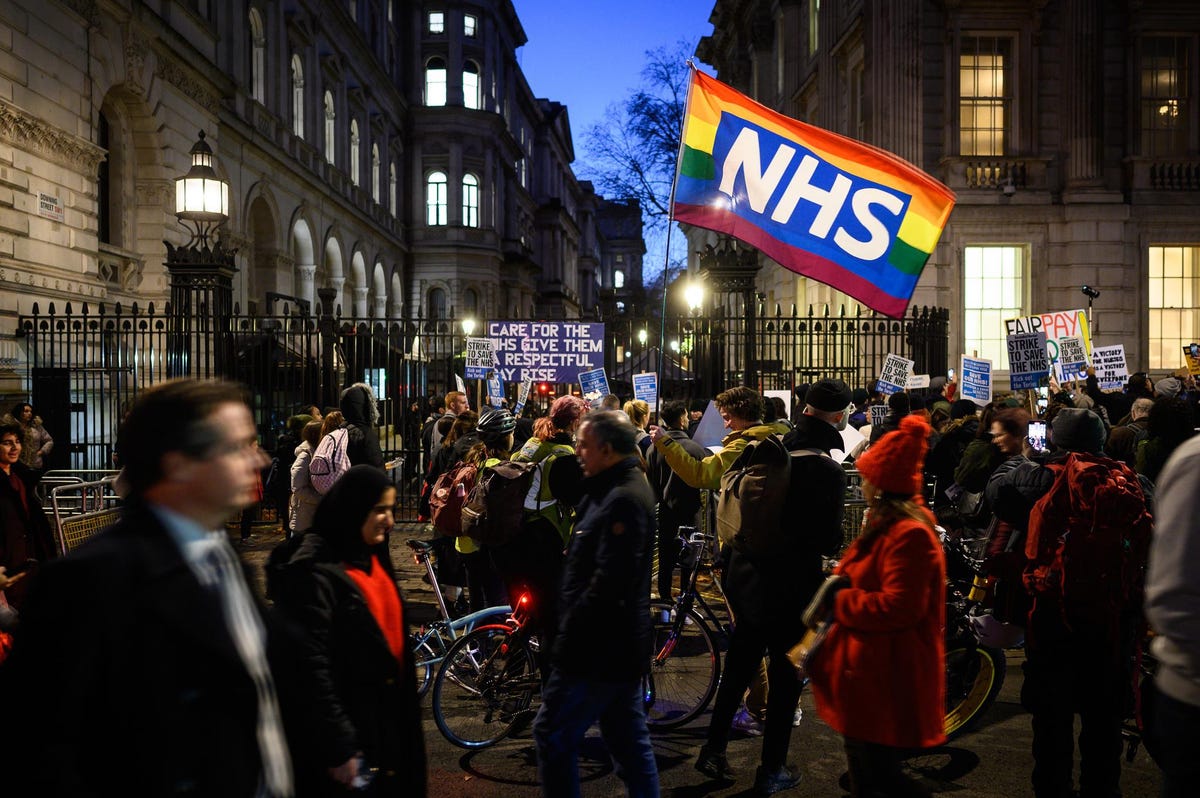[ad_1]
LONDON, UNITED KINGDOM – DECEMBER 20: NHS workers and supporters gather outside Downing Street to … [+]
British nurses and ambulance workers plan to go on strike next month, following three days of industrial action in December.
Hospitals are set to endure four days of action from ambulance workers and nurses over two weeks, should pay negotiations with government ministers fail to materialise.
But although disputes over this year’s salaries is a major factor in the strikes, union leaders argue there is more to the action than paychecks alone.
When will the strikes take place?
In December, thousands of nurses in England, Wales and Northern Ireland restricted their activities twice — on the 15th and 20th — in the first-ever strike of its kind. The Royal College of Nursing has announced two further days of industrial action on January 18 and 19.
Nurses in emergency settings will continue to work, but the strikes could have a significant impact on areas like planned care. Tens of thousands of appointments were cancelled on strike days in December.
Some 25,000 ambulance workers in England with the GMB, Unison and Unite unions also walked out on December 21. Teams still responded to life-threatening calls, but responses to serious, but not immediately life-threatening, calls varied from region to region.
A second strike date proposed by GMB — December 28 — was ultimately called off. But in January, Unison ambulance workers are set to strike twice, on the 11th and 23rd.
Why are healthcare workers striking?
The industrial action is primarily a pay dispute, but it also reflects the intense working conditions many workers have experienced since the start of the pandemic and even before.
Although covid-19 is now putting fewer patients in hospital, experts say the disease has exacerbated existing problems in Britain’s public health system.
Cost of living crisis
This year, National Health Service workers — who are public sector employees — were given a pay rise equivalent to roughly 4.75%. This was recommended by an independent government body called the NHS Pay Review Body.
But in recent months, inflation has risen to double digits as prices for energy and other goods soar, creating a cost of living crisis for many. Union leaders argue the pay deal represents a real terms pay cut, and have asked for much higher increases.
They also say boosting pay will help shore up a long-depleted workforce; that better salaries will improve retention and attract more people into jobs in the health service. In turn, they argue this will improve patient safety.
The government, on the other hand, argues that increasing NHS salaries further would be costly — and fuel inflation itself.
Working conditions
Working conditions are also an important factor in the strikes, with many staff feeling burned out and undervalued nearly three years into a pandemic that — alongside repeated bouts of increased demand and staff absence — brought with it numerous reports of patient aggression towards staff.
Difficult working conditions have long been a problem for ambulance workers who, as the Nuffield Trust notes, tend to experience lower levels of satisfaction than staff in other areas.
This has only intensified as pressures have grown to extreme levels over the last year. Slower-than-usual hospital discharges have left wards with fewer available beds, slowing admission from the emergency department and, in turn, the handover of patients from ambulances. This then limits the number of vehicles and teams available, slowing down response times.
Although there are many factors behind these flow problems, inadequate social care provision — i.e. care home beds and domiciliary care — is considered a key driver. Simply put, some patients who are medically fit to leave may have to wait in hospital while a social care bed opens up.
The impact of strikes
The public health system — by far the biggest provider of healthcare in the U.K. — is already under serious strain with staffing shortages and a lack of adequate social care continuing to put pressure on hospitals.
Rising levels of illnesses like flu and covid-19, as well as scarlet fever and strep throat in children, are also driving up demand for some services.
Hospital leaders helped to mitigate the impact of December’s strikes by trying to disharge patients more quickly where possible and even calling on the armed forces to help drive some ambulances. But every new day of industrial action brings safety risks, as well as a high chance of cancelled appointments.
If pay negotiations are not opened beforehand, it’s likely similar measures will be needed for January’s strikes.
[ad_2]
Source link

